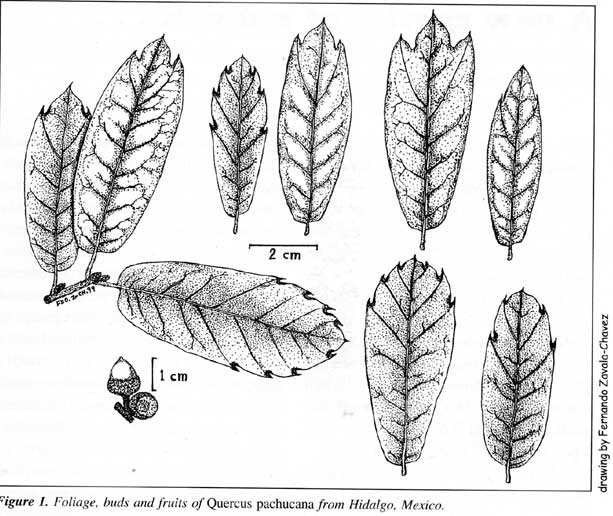| Quercus pachucana | |
| Author | F.Zavala-Chavez 2000 Int. Oaks 10: 31 |
| Synonyms | |
| Local names | |
| Range | Mexico (Hidalgo, Sierra de Pachuca); near 2800 m; |
| Growth habit | 4-6 meters tall, sometimes shrubby, with branches from low on the trunk; |
| Leaves | 3.5-8 cm x 1.5-3, leathery, elliptic-lanceolate or oblanceolate; apex obtuse or acute, usually shortly aristate; base narrower, rounded or subcordate, often asymmetrical; margin flat or weakly wavy, revolute, with 1-2 aristate teeth each side in the distal 1/3; 6-9 vein pairs; hairless, green above, except stellate pubescence at base and along midrib; beneath often bullate, yellowish hairy, with slightly prominent veins; young leaves with short, dense pubescence; petiole reddish brown, 2.5-8 mm long, with persistent stellate tomentum; |
| Flowers | from January to March; |
| Fruits | acorn 1-1.3 cm long, single or paired, stalkless or on a very short peduncle; cup halfround, straight at margin, with flat scales ciliate at margin; maturing in 2 years, from August to November; |
|
Bark, twigs and |
bark grey, fissured into irregular, small, thick, more or less concave plates; twig brown, 1-1.5 mm thick, with minute, dense stellate tomentum and some simple hairs; some lenticels; bud 2-3 mm with more or less pointed apex; stipules 4-5 mm, deciduous when leaves become adult. |
| Hardiness zone, habitat | |
| Miscellaneous | -- Sub-genus Quercus, section
Lobatae, series Erythromexicanae, group Mexicanae; -- Related to Q.crassipes and Q.mexicana; -- Often confused with mexicana (but leaves are toothed) and with crassipes (but the cup's margin is straight). |
| Subspecies and varieties |
|
| Pictures |  |